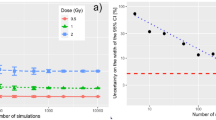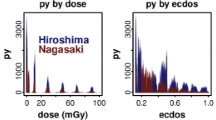Abstract
In cohort studies, unbiased estimation of exposure-outcome associations requires selection of an appropriate reference group of unexposed individuals. We illustrate strategies for analyzing cohort data with multiple potential reference groups. We analyzed the association between radiation exposure and incidence of first primary solid cancer among 105,444 participants of the Life Span Study (Hiroshima and Nagasaki, Japan, 1958–2009). Potential reference groups included zero-dose survivors at different ground distances from the hypocenter (internal) and city residents who were not in either city at the time of the bombings (external). DS02R1 weighted absorbed colon doses were estimated by the DS02 dosimetry system. Piecewise constant hazard models estimated excess relative risks of first primary solid cancer. We focused on sex-averaged excess relative risks and the shape of the dose–response curve. A model with internal standardization provided a sex-averaged excess relative risk of 0.510, 95% confidence interval: (0.414, 0.612) per gray of weighted absorbed colon dose, as well as strong evidence of a curvilinear dose response among males (P = 0.008). Selection of not-in-city residents as the reference group resulted in a larger excess relative risk of 0.560, 95% confidence interval: (0.467, 0.657) per gray, and reduced evidence of a curvilinear dose response among males (P = 0.042). These differences were particularly apparent at weighted absorbed colon doses < 1 gray. In cohort studies, selection of an appropriate reference group requires understanding of the nature of unmeasured confounding to which the results could be sensitive.


Similar content being viewed by others
References
Kleinbaum DG, Kupper LL, Morgenstern H. Epidemiologic research: principles and quantitative methods. Belmont: Lifetime Learning Publications; 1982.
Beebe GW, Usagawa M. The major ABCC samples. ABCC Technical Report 12-68; 1968.
Cullings HM, Fujita S, Funamoto S, et al. Dose estimation for atomic bomb survivor studies: its evolution and present status. Radiat Res. 2006;166:219–54.
Cullings HM, Grant EJ, Egbert SD, et al. DS02R1: improvements to atomic bomb survivors’ input data and implementation of dosimetry system 2002 (DS02) and resulting changes in estimated doses. Health Phys. 2017;112:56–97.
Beebe GW, Ishida M, Jablon S. Studies of the mortality of A-bomb survivors. I. Plan of study and mortality in the medical subsample (selection 1), 1950–1958. Radiat Res. 1962;16:253–80.
Grøn R, Gerds TA, Andersen PK. Misspecified Poisson regression models for large-scale registry data: inference for ‘large n and small p’. Stat Med. 2016;35:1117–29.
Pierce DA, Preston DL. Radiation-related cancer risks at low doses among atomic bomb survivors. Radiat Res. 2000;154:178–86.
Cologne JB, Preston DL. Impact of comparison group on cohort dose response regression: an example using risk estimation in atomic-bomb survivors. Health Phys. 2001;80:491–6.
Pearl J. Causal inference from indirect experiments. Artif Intell Med. 1995;7:561–82.
Grant EJ, Brenner A, Sugiyama H, et al. Solid cancer incidence among the Life Span Study of atomic bomb survivors: 1958–2009. Radiat Res. 2017;187:513–37.
Pierce DA, Stram DO, Vaeth M. Allowing for random errors in radiation dose estimates for the atomic bomb survivor data. Radiat Res. 1990;123:275–84.
Pierce DA, Vaeth M, Cologne JB. Allowance for random dose estimation errors in atomic bomb survivor studies: a revision. Radiat Res. 2008;170:118–26.
Richardson DB, Wing S, Cole SR. Missing doses in the Life Span Study of Japanese atomic bomb survivors. Am J Epidemiol. 2013;177:562–8.
Nishi N, Sugiyama H, Hsu WL, et al. Differences in mortality and incidence for major sites of cancer by education level in a Japanese population. Ann Epidemiol. 2008;18:584–91.
Grant EJ, Ozasa K, Ban N, et al. A report from the 2013 international symposium: the evaluation of the effects of low-dose radiation exposure in the Life Span Study of atomic bomb survivors and other similar studies. Health Phys. 2015;108:551–6.
Breslow NE, Lubin JH, Marek P, et al. Multiplicative models and cohort analysis. J Am Stat Assoc. 1983;78:1–12.
Turner H, Firth D. Generalized nonlinear models in R: an overview of the GNM package. R package version 1.0-8; 2015.
Hollingsworth JW, Beebe GW, Yamasaki. ME-55 adult medical survey, Hiroshima, 1950-53; new series tabulations. ABCC Technical Report 08-61; 1961.
Yamada M, Izumi S. Psychiatric sequelae in atomic bomb survivors in Hiroshima and Nagasaki two decades after the explosions. Soc Psychiatry Psychiatr Epidemiol. 2002;37:409–15.
Honda S, Shibata Y, Mine M, et al. Mental health conditions among atomic bomb survivors in Nagasaki. Psychiatry Clin Neurosci. 2002;56:575–83.
Pierce DA, Vaeth M, Shimizu Y. Selection bias in cancer risk estimation from A-bomb survivors. Radiat Res. 2007;167:735–41.
Lin DY, Psaty BM, Kronmal RA. Assessing the sensitivity of regression results to unmeasured confounders in observational studies. Biometrics. 1998;54:948–63.
Vanderweele TJ, Arah OA. Bias formulas for sensitivity analysis of unmeasured confounding for general outcomes, treatments, and confounders. Epidemiology. 2011;22:42–52.
Rosenbaum PR. Evidence factors in observational studies. Biometrika. 2010;97:333–45.
Rosenbaum PR. Some approximate evidence factors in observational studies. J Am Stat Assoc. 2011;106:285–95.
Acknowledgements
The Radiation Effects Research Foundation (RERF), Hiroshima and Nagasaki, Japan is a public interest foundation funded by the Japanese Ministry of Health, Labour and Welfare (MHLW) and the U.S. Department of Energy (DOE). The research was also funded in part through DOE award DE-HS0000031 to the National Academy of Sciences. This publication was supported by RERF Research Protocol 1-75 and 18-61. The views of the authors do not necessarily reflect those of the two governments. Dr. Eric Grant, Associate Chief of Research at RERF, provided helpful feedback on early drafts of the manuscript.
Author information
Authors and Affiliations
Corresponding author
Ethics declarations
Conflict of interest
The authors declare that they have no conflict of interest.
Electronic supplementary material
Below is the link to the electronic supplementary material.
Rights and permissions
About this article
Cite this article
French, B., Cologne, J., Sakata, R. et al. Selection of reference groups in the Life Span Study of atomic bomb survivors. Eur J Epidemiol 32, 1055–1063 (2017). https://doi.org/10.1007/s10654-017-0337-9
Received:
Accepted:
Published:
Issue Date:
DOI: https://doi.org/10.1007/s10654-017-0337-9




